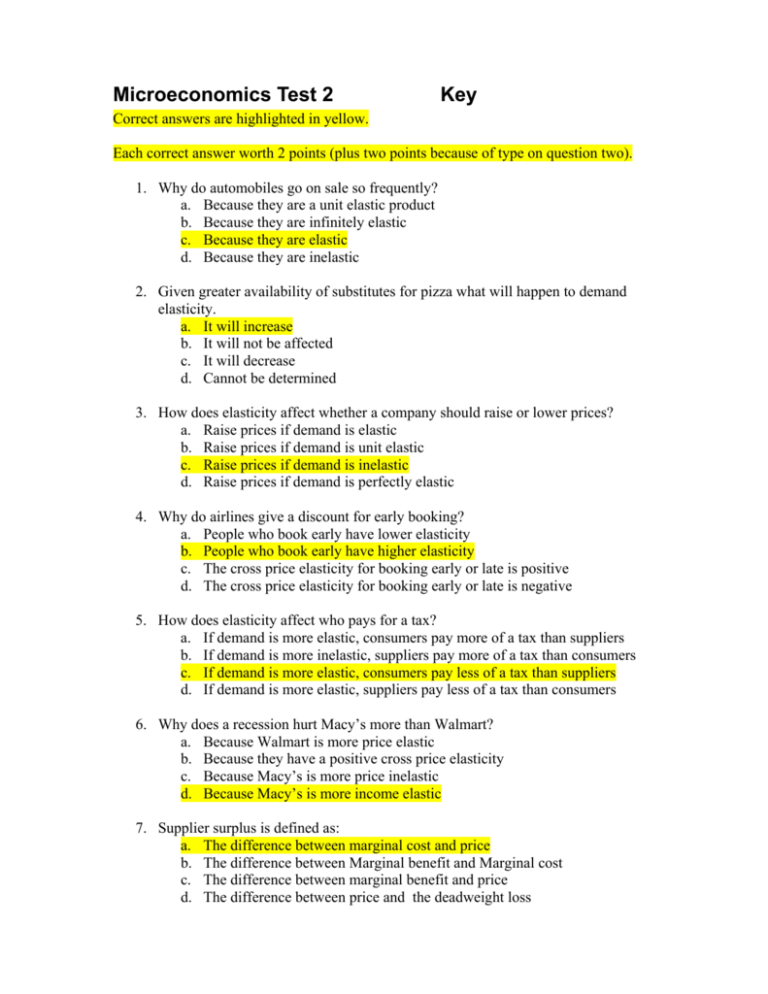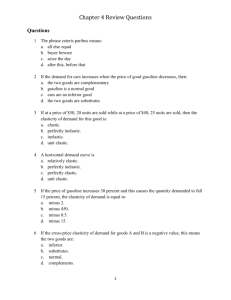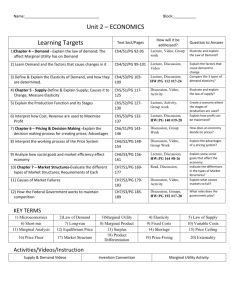Microeconomics Test 2 Key
advertisement

Microeconomics Test 2 Key Correct answers are highlighted in yellow. Each correct answer worth 2 points (plus two points because of type on question two). 1. Why do automobiles go on sale so frequently? a. Because they are a unit elastic product b. Because they are infinitely elastic c. Because they are elastic d. Because they are inelastic 2. Given greater availability of substitutes for pizza what will happen to demand elasticity. a. It will increase b. It will not be affected c. It will decrease d. Cannot be determined 3. How does elasticity affect whether a company should raise or lower prices? a. Raise prices if demand is elastic b. Raise prices if demand is unit elastic c. Raise prices if demand is inelastic d. Raise prices if demand is perfectly elastic 4. Why do airlines give a discount for early booking? a. People who book early have lower elasticity b. People who book early have higher elasticity c. The cross price elasticity for booking early or late is positive d. The cross price elasticity for booking early or late is negative 5. How does elasticity affect who pays for a tax? a. If demand is more elastic, consumers pay more of a tax than suppliers b. If demand is more inelastic, suppliers pay more of a tax than consumers c. If demand is more elastic, consumers pay less of a tax than suppliers d. If demand is more elastic, suppliers pay less of a tax than consumers 6. Why does a recession hurt Macy’s more than Walmart? a. Because Walmart is more price elastic b. Because they have a positive cross price elasticity c. Because Macy’s is more price inelastic d. Because Macy’s is more income elastic 7. Supplier surplus is defined as: a. The difference between marginal cost and price b. The difference between Marginal benefit and Marginal cost c. The difference between marginal benefit and price d. The difference between price and the deadweight loss 8. If a 10% change in price causes a 5% change in quantity, we would say that demand is: a. Elastic b. Unit elastic c. Inelastic d. Perfectly inelastic 9. Suppose total revenues = 100,000 while explicit costs=40,000 and implicit costs/opportunity costs=10,000. Compute accounting and economic profit. a. The economic profit = 10,000 b. The economic profit = 40,000 c. The economic profit = 50,000 d. The economic profit = 60,000 10. Given that total costs are $60 to produce one unit, $150 to produce two units and $250 to produce three units. Find the marginal cost to produce three units: a. $50 b. $100 c. $150 d. $250 11. Using the data from the problem above, if the marginal benefit is $75, how many will be produced and consumed a. 0 b. 1 c. 2 d. 3 12. If the marginal costs for the first three items (beginning at 1) are: 20, 30, 50. Find the total costs for the three items a. 50 b. 70 c. 80 d. 100 13. A person protests that they can’t sell their restored car for $3000 because they have invested $5000 in it already. This demonstrates a misunderstanding of: a. Marginal costs b. Marginal benefit c. Implicit costs d. Sunk costs 14. Diminishing marginal utility means: a. As you consume more, your total utility diminishes b. As you decrease consumption, marginal utility diminishes c. As you consume more, an additional item is worth less d. As you consume less, an additional item is worth less 15. In order for a price decrease to increase revenue, what can we say about elasticity? a. It must be close to zero b. It must be less than 1 c. It must equal 1 d. It must be greater than 1 Essays: Answer each of the following essays on the back side of the test or the extra paper provided. Provide full and complete answers and be sure to DEFINE your terms as you use them. Some questions DO NOT have a single correct answer, therefore, to receive full credit, you must explain your answer. 1. (15 pts) Suppose that you know that elasticity of your product is 1.5 and the cross price elasticity with a competitor is +1.25; and the income elasticity is 1.8. a. Interpret each of these values in terms of elasticity, and percentage effects Key points in answer: • Elasticity of 1.5 means that the product is elastic, a 1% change in price will cause the quantity demanded to decrease by 1.5% • Cross elasticity of +1.25. Since this is positive, the products are considered substitutes. Since this is greater than one, it is elastic. This value means that a 1% change in our competitors price would cause our sales to decrease by 1.25% • Income elasticity of 1.8 means that the product is a normal, elastic good and probably viewed as a luxury. A value of 1.8 means that as consumer income goes up by 1%, our sales will increase by 1.8%. b. The company is considering raising prices to earn more money. What is your advice? • Since the price elasticity is 1.5, they should NOT raise their price. As noted above, if they raise prices by 1%, they will lose 1.5% of their sales and their total revenue will decline. c. Does the cross price elasticity indicate that your customers are loyal or just seeking the best price (explain). • The cross price elasticity of +1.25% indicates that if I change my prices by 1%, then my competitor’s sales may increase by +1.25% (and vice versa). Therefore, it appears that my customers are very willing to switch if the price is right. d. How would your business be affected by a national recession (declining income) • Since the income elasticity is 1.8, I am very susceptible to changes in people’s income. If income goes down by 1%, I may lose 1.8% of my sales. Thus, if a national recession occurs, I am likely to experience dramatically lower sales. This company is like a typical luxury good or like Macy’s used in class. 2. (15 pts) As described in class, adopting stricter airbag standards would cost approximately $1.4 million per life saved per year. If the value of a human life based on lawsuit settlements is $2 million, should we adopt the stricter standards? Explain using an economic analysis. (be sure to define your terms). • Economists approach questions using a marginalist approach and an amoral attitude. That means that they do not consider all of the historical events nor do they consider whether something is right or wrong. They are only concerned about how the costs of an action compare with the benefits. Specifically, they compare the marginal costs and marginal benefits and will act if and only if the marginal benefits are greater than marginal costs. In this case, it indicates that the marginal costs of adopting the stricter airbag requirements are $1.4 million per life saved while the marginal benefit (measured by reduced lawsuit payments) to the company are $2 million per life. Thus, since the marginal benefit exceeds the marginal cost, they SHOULD adopt the stricter standards. 3. (10 pts) Imagine that you are the marketing director for a local restaurant. Using the concept of comparing MU/P, briefly describe 4 possible marketing approaches. (note: it is NOT sufficient to just say increase/decrease Price etc, explain why and how). • Economists believe that people choose what to buy based on its utility to them and specifically the marginal utility per dollar spent (MU/P). When comparing two products, the consumer will choose the item with the higher MU/P. Given that, the goal of marketing is to increase your companies relative MU/P. There are four methods of doing this: 1. Raise your companies MU: This means making your companies product more desirable through either influencing tastes (advertising) or creating scarcity (since it has diminishing marginal utility). By increasing MU, the ratio of MU/P will also increase. 2. Decrease Price: By lowering your companies price, you increase the ratio of MU/P. 3. Decrease your competitor’s MU: You must discourage people from buying their product through persuading them that it is inferior or undesirable or perhaps not faddish. You may do this through negative advertising. You may also attempt to convince people that it is common or abundant which will reduce its MU since it has diminishing marginal utility. If you decrease their MU, their ratio of MU/P decreases making your product relatively appear the better deal. 4. Increase your competitor’s Price: you cannot directly control their price, but you may engage in advertising to imply that the price does not reflect all of the costs of their product. You might imply that there are hidden extra costs or that your product contains features that they would have to pay extra for from your competitor. Alternatively, you may create the impression that there are other opportunity costs associated with buying the other product (potential illness, harm, etc). By increasing their price, you decrease their MU/P, which makes your product a relatively better deal. 4. (15 pts)Suppose the US is considering restricting the imports of clothing from China. Using consumer and producer surplus (and graphs) answer the following: • Graph must show supply and demand with areas of surplus and loss labeled. The graph should show either a decrease (shift left) of supply or a quota restriction. a) How would consumers be affected • As prices increase due to the restriction, consumers would lose consumer surplus. b) How would producers be affected • As prices rise due to the restriction, producers would gain surplus. c) What is a deadweight loss? • A deadweight loss occurs due to the reduced amount of trading and exchange caused by the higher price and restrictions. It is a small triangle between the old and new equilibrium points. 5. (10 pts) How are grocery coupons like popcorn at the movies? (use a graph to help explain). • Both grocery coupons and popcorn at the movies are attempts to charge different prices to different segments of your customers and engage in price discrimination. Price discrimination requires that you identify different groups who have different elasticities of demand. You can charge a higher price to customers with a higher elasticity. Grocery coupons are a case where customers who are more elastic (price sensitive) will probably take the time to clip and bring coupons. People who do not use coupons are probably more inelastic or insensitive to price. Similarly, according to Landsburg, people who also buy popcorn at the movies are typically more inelastic than the general population and can be charged more. However, if they raised the admission price, the non-popcorn lovers would not purchase a ticket. Therefore, to distinguish the two groups, charge higher prices for popcorn. • Graph should show two demand curves inelastic and elastic. BONUS (4 points, not required, all or nothing). Explain using utility theory why you can take as many newspapers as you want, but only one soda at a time from a machine. According to utility theory, the more of something that you consume, the less marginal utility you receive. This is the idea of diminishing marginal utility. A person will only buy something if its marginal utility exceeds its price (benefit>cost). Thus, you are willing to pay less for an additional item because of its lower MU. Getting an additional newspaper or soda will give you less MU than the first. However, not all items decline at the same rate. In the case of newspapers, a second paper is virtually worthless or perhaps negative if considering the weight and effort of carrying it. Assuming that there is some potential cost of taking multiple newspapers (e.g. theft charges, weight etc), you would not want to take more than one. In contrast, an additional soda has only slightly less MU than the first (it can be stored for example). Thus, if they were free for the taking, you would probably take more than one. Therefore, they cannot let you take as many as you want.









